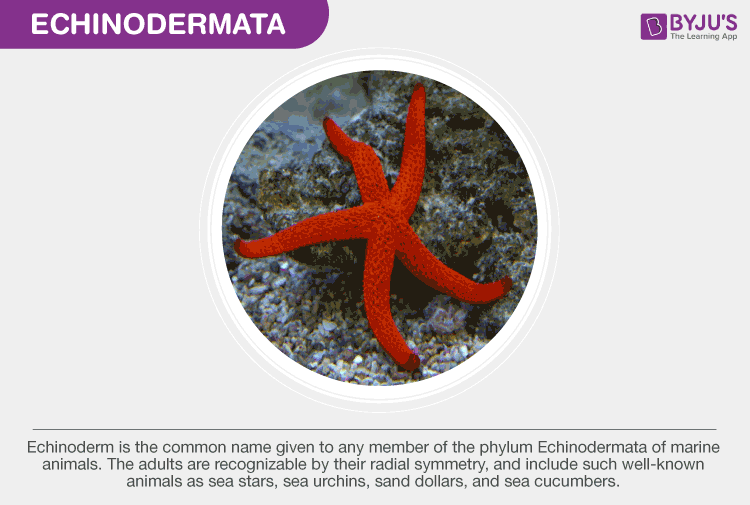
The organisms belonging to the phylum Echinodermata are exclusively marine. Till date, there have been no traces of any terrestrial or freshwater Echinoderms.
These are multicellular organisms with well-developed organ systems. All the animals belonging to this phylum share the same characteristics features. They are colourful organisms with unique shapes. They are ecologically and geologically very important.
The Echinoderms are found in sea-depths as well as in the intertidal zones. An interesting feature of the phylum Echinodermata is that all the organisms belonging to this phylum are marine. None of the organisms is freshwater or marine.
The water vascular system present in echinoderms accounts for gaseous exchange, circulation of nutrients and waste elimination.
Characteristics of Echinodermata
-
They have a star-like appearance and are spherical or elongated.
-
They are exclusively marine animals.
-
The organisms are spiny-skinned.
-
They exhibit organ system level of organization. Most members have a circulatory system as well as a digestive system.
-
They are triploblastic and have a coelomic cavity.
-
The skeleton is made up of calcium carbonate.
-
They have an open circulatory system.
-
They respire through gills or cloacal respiratory tree.
-
They have a simple radial nervous system and the excretory system are absent.
-
The body is unsegmented with no distinct head. The mouth is present on the ventral side while the anus is on the dorsal side.
-
The tube feet aids in locomotion.
-
They reproduce sexually through gametic fusion and asexually through regeneration. Fertilization is external.
-
The development is indirect.
-
They possess the power of regeneration.
-
They have poorly developed sense organs. These include chemoreceptors, tactile organs, terminal tentacles, etc.
Classification of Echinodermata
Asteroidea
-
They have a flattened, star-shaped body with five arms.
-
They have tube feet with suckers.
-
They respire through papulae.
-
The body comprises of calcareous plates and movable spines.
-
Pedicellaria is present.
-
Eg., Asterias, Zoroaster
Ophiuroidea
-
The body is flat with pentamerous discs.
-
The tube feet are devoid of suckers.
-
They respire through Bursae.
-
The long arms are demarcated from the central disc.
-
Eg., Ophiderma, Amphuria
Echinoidea
-
The body is hemispherical.
-
The tube feet contains suckers.
-
The body does not have arms.
-
The body has a compact skeleton and movable spines.
-
Eg., Echinus, Cidaris
Holothuroidea
-
The body is long and cylindrical.
-
The arms, spines, and pedicellariae are absent.
-
They respire through the cloacal respiratory tree.
-
They possess tube feet with suckers.
-
Eg., Cucumaria, Holothuria
Crinoidea
-
The body is star-shaped.
-
The tube feet have no suckers.
-
The arms are bifurcated.
-
Spines and pedicellariae are absent.
-
Eg., Neometra, Antedon
For more information on phylum Echinodermata or any other related topics, keep visiting BYJU’S website or download BYJU’S app for further reference.
Related Links:-
| Bryophyta |
| Pteridophyta |



It really helps a lot
It’s nice
its nice